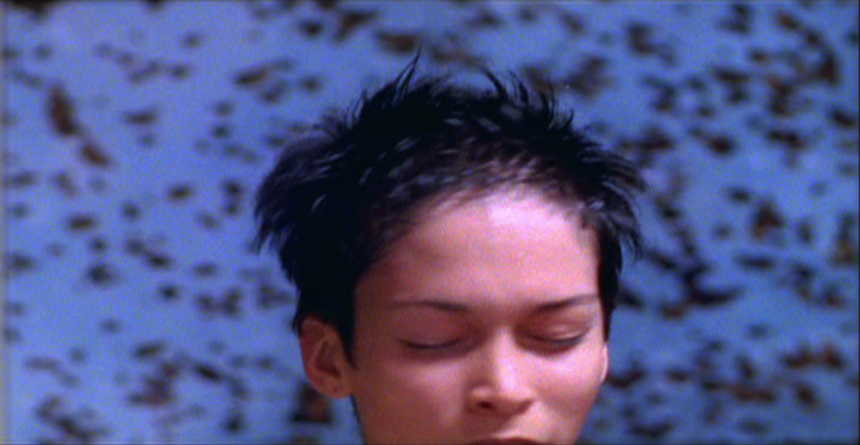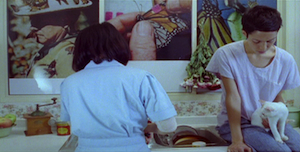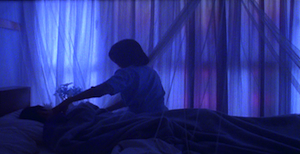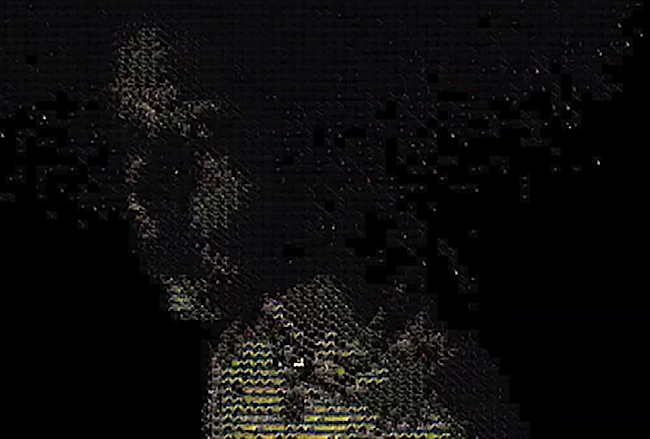Review: SUNDOWNING - At The Edge Of Madness & The Forefront Of The Vanguard

These are the opening, and yes, near exhausting, moments of Frank Rinaldi's debut feature Sundowning.
Sundowning premiered this past January at Slamdance and will be having a limited theatrical run in New York this weekend at the Anthology Film Archives as part of their series Show and Tell, which is, as they put it, "[ a showcase for] work by individuals operating at the vanguard of non-commercial cinema." And it's hard to mistake Rinaldi and his small cast and crew from NYU's Tisch Asia Program operating from any other place than that of the vanguard.
Shannon Fitzpatrick is Shannon: the patient. Susan Chau is Susan: the caretaker. The women live in an apartment adorned with plants and flowers the two shape and prune daily; a place where the windows to the outside world (so distant, so foreign) are blocked out by posters of butterflies. In this apartment practicality, with a splash of calm color and tidbits from nature, rules the day, which is dictated by the safety of routine. You see Shannon is a young woman who suffers from dementia. And she experiences symptoms of sundowning, wherein the sufferer becomes increasingly off-kilter and irritable as night approaches. Hyper memory loss occurs; great mental and physical agitation can breakdown sleep, her circadian rhythms. Keeping routine, keeping things relaxed and safe is best.
 Susan sees to this with the utmost care and diligence. Day in day out. Shower in the morning, yoga, lunch with a full glass of milk (every, every drop), pruning, light cleaning, dancing, reading (usually about the migration of Monarch butterflies), bedtime with a video of butterflies emerging from the cocoon and... Day 256. Day 357. Day 422. Day 511. Day in day out, with few changes. But at night, the television flickering at the foot of the bed, Susan coolly commands Shannon to lie down and close her eyes. Like a small child Shannon obeys. And at first with the mechanical movements of routine intact, Susan pulls out from under the bed a sleek black hand-held device, flicks it on and it's as if the entire rooms hums, heavy with electricity, and then -- a snap! a sizzle! and... morning and safety. It was at this moment when I squirmed in my seat, my mind racing -- Now just what is going on here? Is this some kind of intense therapy or a cruel experiment?
Susan sees to this with the utmost care and diligence. Day in day out. Shower in the morning, yoga, lunch with a full glass of milk (every, every drop), pruning, light cleaning, dancing, reading (usually about the migration of Monarch butterflies), bedtime with a video of butterflies emerging from the cocoon and... Day 256. Day 357. Day 422. Day 511. Day in day out, with few changes. But at night, the television flickering at the foot of the bed, Susan coolly commands Shannon to lie down and close her eyes. Like a small child Shannon obeys. And at first with the mechanical movements of routine intact, Susan pulls out from under the bed a sleek black hand-held device, flicks it on and it's as if the entire rooms hums, heavy with electricity, and then -- a snap! a sizzle! and... morning and safety. It was at this moment when I squirmed in my seat, my mind racing -- Now just what is going on here? Is this some kind of intense therapy or a cruel experiment?Cinematographer Kiran Chitanbis' expertly framed masters of Susan and Shannon -- in the living room, in bed, at the dining table -- and then the juxtaposing tight, suffocating hand-held camera in the bathroom, at night when Shannon's world begins to crumble, ratchets up the tension Rinaldi and his actors have cultivated on a near simmer of a slow-burn. Moments that are pierced by Thomas Seely's Martian-esque sound design and score create an often chilling, increasingly paranoid soundprint for a picture where someone yearns to ask why, but must first wake up enough to remember what questioning even is. As the second act glides along, and routines began to lose their careful steps -- Susan lacking energy and focus in her tasks, Shannon beginning to rebel; the motifs of the butterfly, the cocoon and of the feminine coalescing -- there came a point in Sundowning where I just couldn't stop saying, "Wow."
For those readers that don't further wish the form and tone (not really the narrative) of the film to be spoiled, in the following paragraphs I do discuss how the film plays out via Rinaldi's choices in non-linear and experimental techniques, and thus, its formal and tonal shifts. If you wish to skip this section, please jump ahead to the final paragraph.
It is clear enough that from its opening frames Sundowning is a film that is unwilling to give anything of itself away for free. You've gotta work with it every step of the way. With no relative back story, and a very slow reveal of motivations, it's ambiguity (albeit over a fairly traditional narrative) could frustrate some audiences exponentially, making them wonder if Rinaldi and co. have a plan, a process, a destination to this journey... or else, is this all just an exercise? And is that actually okay?
 Let me get into it a bit more. You see, the final act shifts dramatically: in mood, in style, -- heck, it even vaults from the soft, gauzy, world of 16mm, to the jumpy, lo-fi helter-skelter of videotape. This is quite literally the reality of the film changing, shifting; simultaneously collapsing in on itself and pulling away -- just as it demands to be looked at. This is a point where people could most certainly check out, however none of these choices come out of the blue. As Shannon becomes increasingly paranoid and free of Susan's guiding hand Rinaldi peppers the frame with such visual effects and techniques as obvious color filtering, clicks and pops, reel markers, video artifacts, looping dialog samples to near near musical effect, and excessive pixelation. Does this then result in the picture diverging solely into a stylistic exercise with sci-fi trappings? (a sort of pre-Youtube computer haze latticed by a cornucopia of grids and matrices constantly assembling and disassembling themselves into pictures) -- i.e. Is this just cool to look at? Or is this the often complex and scary world of dementia fully personified on the cinematic plane?
Let me get into it a bit more. You see, the final act shifts dramatically: in mood, in style, -- heck, it even vaults from the soft, gauzy, world of 16mm, to the jumpy, lo-fi helter-skelter of videotape. This is quite literally the reality of the film changing, shifting; simultaneously collapsing in on itself and pulling away -- just as it demands to be looked at. This is a point where people could most certainly check out, however none of these choices come out of the blue. As Shannon becomes increasingly paranoid and free of Susan's guiding hand Rinaldi peppers the frame with such visual effects and techniques as obvious color filtering, clicks and pops, reel markers, video artifacts, looping dialog samples to near near musical effect, and excessive pixelation. Does this then result in the picture diverging solely into a stylistic exercise with sci-fi trappings? (a sort of pre-Youtube computer haze latticed by a cornucopia of grids and matrices constantly assembling and disassembling themselves into pictures) -- i.e. Is this just cool to look at? Or is this the often complex and scary world of dementia fully personified on the cinematic plane? My feeling is that Rinaldi has taken far too much care up to this point to so easily throw it away on just the former.
Okay then, let's effectively end spoilers.
While Rinaldi's increasing boldness may turn off some -- and there is a part of me that would have preferred some information to be a little more doled out in transitioning from the second to third acts, rather than shoved on us almost all at once -- I applaud him for committing to a complex set of ideas, themes and emotions. He has come out the other side of the looking glass with an expressive and equally restrained first feature. Never betraying its roots as a somber and minimalist character study, Sundowning is a wildly adventurous picture, unafraid of contrasting itself, essentially uprooting the medium that it exists in for the sake of exploring the vast psychological depths of perception. That is to say it goes as close to the tipping point as it can, observing its own virtual, and indeed thrilling, destruction -- For as Shannon reads over and over again in one crucial scene: destruction plus reproduction is reconstruction.
Sundowning has its New York premiere this Friday, August 10th, 7:30PM at The Anthology Film Archives. It will again play Saturday, August 11th, and Sunday, August 12th, also at 7:30PM. Frank Rinaldi will be participating in Q&As after each screening. For more information on this weekend's screenings, please visit Anthology Film Archives. And to keep an eye on where Sundowning may show next, visit Sundowningthemovie.com


Do you feel this content is inappropriate or infringes upon your rights? Click here to report it, or see our DMCA policy.






